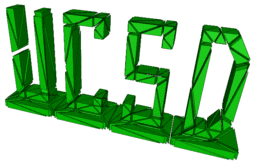| Michael Holst | ||
| https://ccom.ucsd.edu/~mholst/ |
Distinguished Professor of Mathematics and Physics UC San Diego |
|
|
Math 171B (Mathematical Programming)
Course Topics: Numerical methods for nonlinear optimization Instructor: Prof. Michael Holst (5739 AP&M, mholst@math.ucsd.edu; Office Hours: MW 1-2pm) TA: Daniel Robinson (VOLUNTEER; 5748 AP&M, drobinso@math.ucsd.edu; Office Hours: W 12:30pm-2:00pm) Term: Spring 2005 Lecture: 10:00a-10:50a MWF, HSS 1305; Discussion: TBA Textbook(s): P.E. Gill and M.H. Wright, NUMERICAL OPTIMIZATION, Available at Soft Reserves. Main Class Webpage: http://ccom.ucsd.edu/~mholst/teaching/ucsd/171b_s05/index.html Homework Webpage: http://ccom.ucsd.edu/~mholst/teaching/ucsd/171b_s05/hw/index.html CATALOG DESCRIPTION: 171A-B. Mathematical Programming/Numerical Optimization (4-4) Mathematical optimization and applications. Linear programming, the simplex method, duality. Nonlinear programming, Kuhn-Tucker theorem. Selected topics from integer programming, network flows, transportation problems, inventory problems, and other applications. Three lectures, one recitation. Prerequisites: Math. 20F and knowledge of programming. COURSE INFORMATION: Problems in all areas of mathematics, science, and engineering can be posed as optimization problems. An optimization problem begins with a set of independent variables or parameters, and often includes a set of side conditions which define acceptable values of the variables for the particular application. These side conditions are known as constraints. The second component of an optimization problem is a measure of goodness called the objective function, which depends in some way on the constrained variables. The solution of an optimization problem is a (possibly non-unique) set of allowed values of the independent variables for which the objective function reaches its "optimal" (maximal or minimal) value. While Math 171A dealt mainly with linear programming, Math 171B deals mainly with nonlinear programming. This involves the minimization of a nonlinear objective function, possibly subject to nonlinear constraints in the form of equalities or inequalities. For historical reasons, this subject area is often called mathematical programming. The modern terminology for this subject is simply optimization, and the numerical algorithms we study form the subject of numerical optimization. LECTURES AND HOMEWORKS: The lectures topics and the corresponding homeworks problems (a combination of theory problems and computer problems) are posted on the separate Homework webpage (listed above). While the page you are viewing now is visible outside UCSD, the Homework Webpage is only visible to computers on the UCSD campus (you may have trouble viewing it from home). You should read the relevant sections in the text before the lectures in order to get the most from the lectures. The lectures will highlight the important parts of the material, but there will not be time in lecture to cover all of the material in each section in detail. Therefore, having access to, and reading, the textbook is an important component of the course. GRADES, EXAMS, DATES: Your scores on the theory and computer homeworks form 20% of your grade. The remainder of your grade will be calculated from your performance on two midterm exams and one final exam, to be given on the dates below. EXAM DATES:
|
